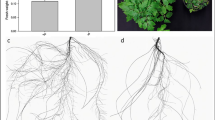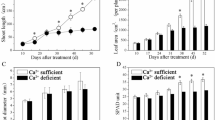Abstract
THE absorption of calcium by plant tissue generally has been considered to be a process involving metabolic uptake. Fried et al.1, using excised barley roots, and Chasson and Levitt2, using potato slices, found a rapid initial uptake of calcium-45 followed by a slower linear increase with time. The linear phase was interpreted to represent metabolic absorption of calcium at a constant rate. However, Moore et al.3, in experiments with excised barley roots, found that when the uptake of inert calcium was determined by chemical analysis, the linear phase increased only slightly with time. When the uptake of calcium-45 was measured, the increase in the linear phase was much more pronounced, presumably because of exchange of radioactive calcium for inert calcium present in the root tissues. In addition, calcium uptake was not reduced by low temperature or treatment with dinitrophenol. Consequently, Moore et al. concluded that in barley roots, calcium uptake was largely non-metabolic in the physiological pH range. Handley and Overstreet4 have reported that calcium uptake in primary roots of maize is non-metabolic in the meristematic portions of the root tip, but is largely metabolic in the older vacuolated portions of the root. In a recent examination of calcium accumulation in barley seedlings, Barber and Koontz5 concluded that metabolism was involved in the process by which calcium was eventually accumulated by the barley shoot.
This is a preview of subscription content, access via your institution
Access options
Subscribe to this journal
Receive 51 print issues and online access
$199.00 per year
only $3.90 per issue
Buy this article
- Purchase on Springer Link
- Instant access to full article PDF
Prices may be subject to local taxes which are calculated during checkout
Similar content being viewed by others
References
Fried, M., Noggle, J. C., and Hagen, C. E., Soil Sci. Soc. Amer. Proc., 22, 495 (1958).
Chasson, R. M., and Levitt, J., Physiologia Plantarum, 10, 889 (1957).
Moore, D. P., Jacobson, L., and Overstreet, R., Plant Physiol., 36, 53 (1961).
Handley, R., and Overstreet, R., Plant Physiol., 36, 766 (1961).
Barber, D. A., and Koontz, H. V., Plant Physiol., 38, 60 (1963).
Arisz, W. H., Helder, R. J., and Van Nie, R., J. Exp. Bot., 3, 257 (1951).
Rosenburg, T., Active Transport and Secretion, Symp. Soc. Exp. Biol., 8 27 (1954).
Author information
Authors and Affiliations
Rights and permissions
About this article
Cite this article
LOPUSHINSKY, W. Calcium Transport in Tomato Roots. Nature 201, 518–519 (1964). https://doi.org/10.1038/201518a0
Issue Date:
DOI: https://doi.org/10.1038/201518a0
Comments
By submitting a comment you agree to abide by our Terms and Community Guidelines. If you find something abusive or that does not comply with our terms or guidelines please flag it as inappropriate.



